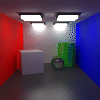


The Dagstuhl Seminars on Rendering, Schloss Dagstuhl, Germany (June 1996).
In spite of constant progress on sophisticated deterministic solution methods for the global illumination problem, Monte Carlo techniques still play an important role, e.g. for final gather passes. I present an overview of classical Monte Carlo techniques and their application to physically based rendering. I recall the basic principles and then discuss the influence of taking more samples, stratifying them, using antithetic variates, control variates, importance sampling, adaptive sampling and Russian roulette. Graphs illustrate how variance reduction techniques are nothing else than transformations of the original integral. The resulting functions are hopefully flatter, so that they are easier to integrate. Specific results obtained from tests with the optimisations, for a set of test scenes rendered with path tracing and bidirectional path tracing, indicate the importance of stratified sampling and of importance sampling for these algorithms.
The transparencies of this talk are available on-line as a gzip'ed Postscript file (13 pages, 35 KBytes, expands to 145 KBytes).
The test images referred to are those from my PhD dissertation: